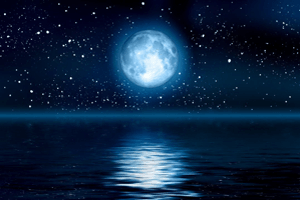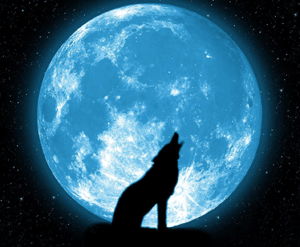 As the song goes, "every
once in a blue moon, I do something
right." I imagine we all feel that way
sometimes. But have you ever wondered
when you can expect to find a
blue moon (so you'll know when you
can expect you'll finally get it right?)
Well guess what - we can't even
seem to get that right!
As the song goes, "every
once in a blue moon, I do something
right." I imagine we all feel that way
sometimes. But have you ever wondered
when you can expect to find a
blue moon (so you'll know when you
can expect you'll finally get it right?)
Well guess what - we can't even
seem to get that right!
There are two known methods for determining a blue moon. One is quite old and is the one that purists prefer (but as you will see is confusing). The other is quite recent and is most commonly known probably because it is fresh in our collective memory from a reliable source.
It's the time of the season
The Maine Farmer's Almanac is credited with printing the original definition in 1937, although research shows earlier uses of the term at least another 100 years prior to this. There are normally only 12 full moons in a year. This means there are normally only three full moons per season. But a rare occurrence happens when a season can envelop four full moons.
Due to the fact that the first, second and last moons in a season have definitions and names (primarily for religious or calendrical purposes) it is the third full moon out of four in a season that is rare. When the compilers of The Maine Farmer's Almanac would list when the full moons were going to be, they used a colored symbol for each one. The third full moon of four during a season was colored blue in print, and this is one story of the origin of the term "blue moon".
Because this will only happen during seasons, the months that can have such a blue moon are February, May, August and November. If we use this method of calculating a blue moon, then there was one on February 19, 2000. The last one was either in August or November of 2002. There was some uncertainty because of when the seasons begin according to different sources.
The earth's orbit around the sun is elliptical, which gives us seasons of unequal length. Spring and summer last slightly longer than autumn and winter in the northern hemisphere. Because of this, an astronomer is likely to observe that a blue moon would occur in spring or summer because the odds of one of these seasons bounding four full moons is higher.
On the other hand, The Maine Farmer's Almanac, defined the start of each season according to the "Right Ascension of the Mean Sun". This is a system that averages out the amount of time during the earth's orbit, simplifying each season to equal length. Truly these systems only differ by a few days, but a few days difference between starts of seasons can change where the full moons appear during that season. Because of their equal length season rule, The Maine Farmer’s Almanac said that the 2002 Blue Moon was November 19th. However, astronomical research based on the U.S. Naval Observatory data showed that the 2002 third full moon of four was during the summer on August 22nd, so that would have been the proper Blue Moon.
September's full moon, which landed on the 21st, was the point of contention. Astronomically speaking, the Autumnal Equinox did not arrive until September 23rd, so September's full moon was the last one of the summer of 2002. The Maine Farmer's Almanac, listed the first day of autumn as Sept. 21st derived that they occurred on the same day, and therefore this was the first full moon of autumn 2002. This in effect extended autumn to be large enough to hold four full moons, asserting then that November's moon would have been the third of four.
Sky & Telescope magazine confused things even more
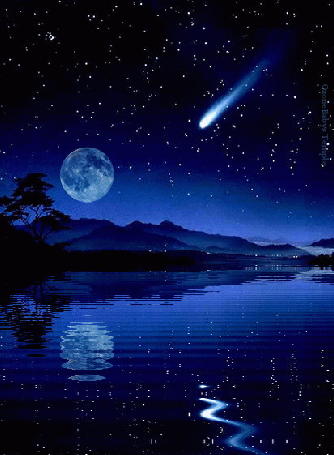 Thanks to a misinterpretation
of this rule published in the
March 1946 issue of Sky & Telescope
magazine, and then repeatedly
used afterwards, we have a new
(and completely different) rule. An
article was written that attempted to
explain when a blue moon would
occur. Instead of giving the rule, the
author attempted to observe when it
fell. (Seeing how much confusion we
have with when seasons start, I can
understand why.)
Thanks to a misinterpretation
of this rule published in the
March 1946 issue of Sky & Telescope
magazine, and then repeatedly
used afterwards, we have a new
(and completely different) rule. An
article was written that attempted to
explain when a blue moon would
occur. Instead of giving the rule, the
author attempted to observe when it
fell. (Seeing how much confusion we
have with when seasons start, I can
understand why.)
As a result, he determined that the second full moon in a month was considered a blue moon. This tends to happen about as often as determined by the original rule, except about a year earlier! Not only that, but following this rule, you can actually have two blue moons in one year. Moreover, confusion will set in over which months have the blue moon because of when a moon is "full" in which time zone.
Following this second rule, 2001 had a blue moon. But depending on which time zone you lived in, you would find it in different months. Specifically, if you lived in the USA, between Chicago and the West Coast, we enjoyed the blue moon on October 31st. Folks between New York and Moscow found it to be on November 30th. Should you be further east than Moscow, the blue moon was on December 30th. This tricky calculation comes from the fact that you have to determine when the moon is "astronomically full".
Here in Arizona, there was a full moon on October 2 and October 31st. But that moon on October 31st here wasn't "full" in New York until after midnight their time. Therefore it was not the second full moon of October, but the first full moon of November. Since it looks full on October 31st and November 1st, it probably makes no difference. Most calendars and almanacs are printed assuming Eastern Standard Time, so they marked the full moon on November 1st and claimed the November 30th moon to be blue.
Don't let these rules make you loony!
So when is the next blue moon? If you were an astronomical purist, almanac farmer or follow ancient rituals, you would probably agree it is on August 19, 2005. If you read Sky & Telescope, or just want the easiest most common rule, the next one will be July 31, 2004. Personally, I say celebrate them both!
The following table lists all of the full moons for the next few years. The full moons listed in bold are blue moons based on the above rules. The times of day given in the table are in "Greenwich Mean Time" (GMT), also known as "Universal Coordinated Time" (UTC), or "Zulu Hours"; so don't forget to adjust for your time zone and Daylight Saving rules. In the U.S. this is the following:
Eastern (EST) = GMT-5, Central (CST) = GMT-6, Mountain (MST) = GMT-7, and Pacific (PST) = GMT-8. Arizona is always GMT-7 and Hawaii is always GMT-10. Daylight Saving Time adds one hour and starts on the first Sunday of April and ends on the last Sunday of October. In practice, we "spring forward and fall back" at 1:59 A.M.
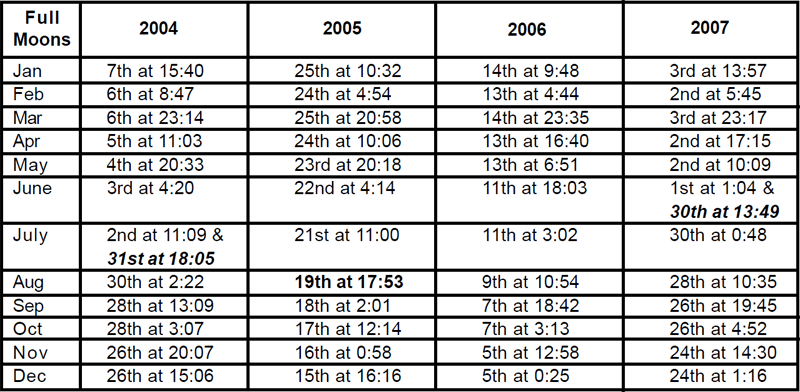
More lunacy from naming the moons
For your reference, I have assembled a list of the common seasonal names for each full moon. Remember, many religious holidays (like Easter) and festivals (like Mardi Gras and Carnivale) depend on seasonal moons. This is by no means the "correct" list of names for the moons, as many different regions and cultures have their own names, sometimes associated by the calendrical month not the season.
Some almanacs conflict on naming conventions even with regards to the seasons; take the Harvest Moon for example. Some say it is the first full moon of autumn; meaning on or after the autumnal equinox. Others claim it to be the full moon closest to first day of autumn; in other words, it could come days before the autumnal equinox.
Table of Common Seasonal Moon Names
Winter 1st - Moon after Yule
Winter 2nd - Wolf Moon
Winter last - Lenten Moon
Spring 1st - Egg, Easter, or Paschal Moon
Spring 2nd - Milk Moon
Spring last - Flower Moon
Summer 1st - Hay Moon
Summer 2nd - Grain Moon
Summer last - Fruit Moon
Autumn 1st - Harvest Moon
Autumn 2nd - Hunter's Moon
Autumn last - Moon before Yule
Table of Starts of the Seasons
These dates and times are the astronomical observances in GMT, so again please adjust for your time zone and daylight saving rules as above.
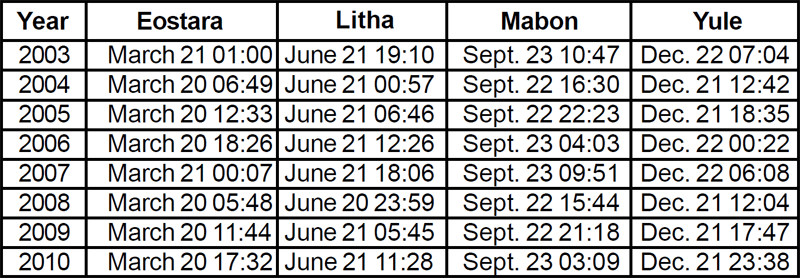
Did you know?
Hawaii is the only state in the union that uniformly chooses not to observe Daylight Saving Time. While the state of Arizona does not observe DST, the Navajo Nation in Arizona DOES. This is due to its large size, which locates it in three states, so they chose to observe it throughout their sovereign nation.
Central Indiana does not observe the change and always remains under Eastern Standard Time. This is because the western portion is in the Central time zone and does observe DST, so when it jumps ahead it is the same time as Central Indiana. The eastern part of Indiana observes it, so when it sets the clocks back, it matches Central Indiana (back to Eastern Standard Time.) This gives many people the illusion that Indiana changes time zones.
The territories of the U.S. that do not observe the change are American Samoa, Guam, Puerto Rico, and the Virgin Islands.



